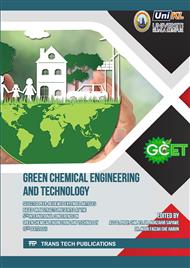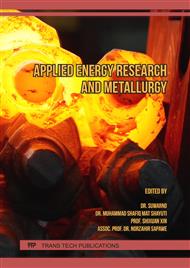[1]
K. S. Ong, Temperature reduction in attic and ceiling via insulation of several passive roof designs,, Energy Conversion and Management, vol. 52, no. 6 (2011): 2405–2411.
DOI: 10.1016/j.enconman.2010.12.044
Google Scholar
[2]
K. Ulgen, Experimental and theoretical investigation of effects of wall's thermophysical properties on time lag and decrement factor,, Energy and Buildings, vol. 34, no. 3 (2002): 273–278.
DOI: 10.1016/s0378-7788(01)00087-1
Google Scholar
[3]
M. W. Muhieldeen and Y. C. Kuang, Saving Energy Costs by Combining Air-Conditioning and AirCirculation using CFD to Achieve Thermal Comfort in the Building,, Journal of Advanced Research in Fluid Mechanics and Thermal Sciences, vol. 58, no. 1 (2019): 84–99.
Google Scholar
[4]
S. S. Saha and V. W. Tam, Insulated wall systems to tackle global warming,, Organization, Technology and Management in Construction: An International Journal, vol. 4, no. 2 (2012).
DOI: 10.5592/otmcj.2012.2.6
Google Scholar
[5]
M. W. Muhieldeen, N. M. Adam, and B. H. Salman, Experimental and numerical studies of reducing cooling load of lecture hall,, Energy and Buildings, vol. 89 (2015): 163–169.
DOI: 10.1016/j.enbuild.2014.12.026
Google Scholar
[6]
L. K. Moey, M. F. Kong, V. C. Tai, T. F. Go, and N. M. Adam, Effects of gable roof angle on natural ventilation for an isolated building,, Journal of Mechanical Engineering and Sciences, vol. 15, no. 3 (2021): 291–300.
DOI: 10.15282/jmes.15.3.2021.15.0659
Google Scholar
[7]
M. W. Muhieldeen, Y. R. Lim, S. Govinda, and W. Y. Tey, Investigation of the Effect of Awning using Sunlight Sensor to Reduce Cooling Load in the Room,, Journal of Advanced Research in Fluid Mechanics and Thermal Sciences, vol. 67, no. 1 (2020): 136–145.
Google Scholar
[8]
F. A. Ansari, A. S. Mokhtar, K. A. Abbas, and N. M. Adam, A simple approach for building cooling load estimation,, American Journal of Environmental Sciences, vol. 1, no. 3 (2005): 209–212.
DOI: 10.3844/ajessp.2005.209.212
Google Scholar
[9]
M. W. Muhieldeen, Q. Y. Wong, U. Z. Abd Rahman, and W. Y. Tey, Energy Saving by Applying Different Wall Thermal Insulations on a Room at Malaysian Institution", Journal of Advanced Research in Fluid Mechanics and Thermal Sciences 65 no. 1 (2020): 130–139.
Google Scholar
[10]
L. K. Moey, M. F. Kong, V. C. Tai, T. F. Go, and N. M. Adam, Effects of roof configuration on natural ventilation for an isolated building,, Journal of Mechanical Engineering and Sciences, vol. 15, no. 3 (2021): 8379–8389.
DOI: 10.15282/jmes.15.3.2021.15.0659
Google Scholar
[11]
M. W. Muhieldeen, C. L. Lim, M. S. S. Kassim, W. Y. Tey, K. H. Teng, The optimum thickness of rockwool as roof thermal insulation: An experimental and Numerical Study,, Journal of Advanced Research in Fluid Mechanics and Thermal Sciences, vol. 89, no. 1 (2022): 77–91.
DOI: 10.37934/arfmts.89.1.7791
Google Scholar
[12]
J. Michalak, S. Czernik, M. Marcinek, and B. Michałowski, Environmental burdens of external thermal insulation systems. expanded polystyrene vs. Mineral Wool: Case Study from Poland,, Sustainability, vol. 12, no. 11 (2020): 4532.
DOI: 10.3390/su12114532
Google Scholar
[13]
M. W. Muhieldeen, Z. Y. Lim, C. L. Lim, and N. M. Adam, Analysis of optimum thickness of glass wool roof thermal insulation performance, Journal of Advanced Research in Fluid Mechanics and Thermal Sciences 76, no. 3 (2020): 1-11.
DOI: 10.37934/arfmts.76.3.111
Google Scholar
[14]
Abhiviran Vimal Subramaniam, Mohammed W. Muhieldeen, Rodney Tan Hean Gay, Lim Chong Lye, Reducing The Energy Cost of Buildings Using Shading Plates: Experimental and Numerical Study,, Journal of Advanced Research in Fluid Mechanics and Thermal Sciences 94, Issue 2 (2022) 1-12.
DOI: 10.37934/arfmts.94.2.112
Google Scholar
[15]
A. M. Nugroho, M. H. Ahmad, and D. R. Ossen, A preliminary study of thermal comfort in Malaysia's single storey terraced houses,, Journal of Asian Architecture and Building Engineering, vol. 6, no. 1 (2007): 175–182.
DOI: 10.3130/jaabe.6.175
Google Scholar
[16]
M. Kameni Nematchoua, P. Ricciardi, S. Reiter, and A. Yvon, A comparative study on optimum insulation thickness of walls and energy savings in equatorial and tropical climate,, International Journal of Sustainable Built Environment, vol. 6, no. 1 (2017): 170–182.
DOI: 10.1016/j.ijsbe.2017.02.001
Google Scholar
[17]
Q. Roslan, S. H. Ibrahim, R. Affandi, M. N. Mohd Nawi, and A. Baharun, A literature review on the improvement strategies of passive design for the roofing system of the modern house in a hot and humid climate region,, Frontiers of Architectural Research, vol. 5, no. 1 (2016): 126–133.
DOI: 10.1016/j.foar.2015.10.002
Google Scholar
[18]
A. B. Ramly, and M. A. A. Hussain, The effect of roof angles on indoor air temperatures in terrace houses in Malaysia,, Journal of Design and Built Environment, vol. 2, no. 1 (2012): 68–79.
Google Scholar
[19]
N. Sadafi, E. Salleh, L. C. Haw, and Z. Jaafar, Evaluating thermal effects of internal courtyard in a tropical terrace house by Computational Simulation,, Energy and Buildings, vol. 43, no. 4 (2011): 887–893.
DOI: 10.1016/j.enbuild.2010.12.009
Google Scholar
[20]
N. Jamaludin, N. I. Mohammed, M. F. Khamidi, and S. N. Wahab, Thermal comfort of residential building in Malaysia at different micro-climates,, Procedia - Social and Behavioral Sciences, vol. 170 (2015): 613–623.
DOI: 10.1016/j.sbspro.2015.01.063
Google Scholar
[21]
J. Song and X. Meng, The improvement of ventilation design in school buildings using CFD simulation,, Procedia Engineering, vol. 121 (2015): 1475–1481.
DOI: 10.1016/j.proeng.2015.09.073
Google Scholar
[22]
B. H. Salman, M. Z. Hamzah, J. Purbolaksono, J. I. Inayat-Hussain, H. A. Mohammed, and M. W. Muhieldeen, Determination of correlation functions of the oxide scale growth and the temperature increase,, Engineering Failure Analysis, vol. 18, no. 8 (2011): 2260–2271.
DOI: 10.1016/j.engfailanal.2011.08.001
Google Scholar
[23]
P. Francesca, W. Y. Tey, L. K. Tan, and M. W. Muhieldeen, Investigation on generalised trapezoidal differencing time-marching scheme for modelling of acoustical wave., CFD Letters 12, no. 2 (2020): 11–21.
Google Scholar
[24]
Y. H. Ng, W. Y. Tey, L. K. Tan, G. P. Arada, and M. W. Muhieldeen. Numerical examination on two-equations turbulence models for flow across NACA 0012 airfoil with different angle of attack., CFD Letters, vol. 12, no. 2 (2020): 22–45.
Google Scholar
[25]
W. Y. Tey, Wah Yen, N. A. C. Sidik, Y. Asako, M. W. Muhieldeen, and O. Afshar, Moving least squares method and its improvement: A concise review,, Journal of Applied and Computational Mechanics 7, no. 2 (2021): 883-889.
Google Scholar
[26]
S. Hayytov, W. Y. Tey, H. S. Kang, M. W. Muhieldeen, and O. Afshar, Comparative review on computational performance of multistep schemes in solving one-dimensional linear wave equation,, CFD Letters, vol. 13 no. 6 (2021): 1–14.
DOI: 10.37934/cfdl.13.6.114
Google Scholar



